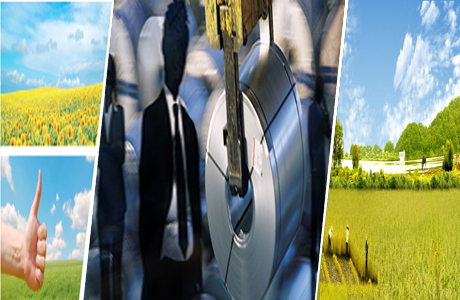Agriculture is our golden goose;
don’t kill her, my dear Industrialists
By
Usman Masood
 The
projection of economic growth as something evil, that
benefits only the rich, is wrong.
The
projection of economic growth as something evil, that
benefits only the rich, is wrong.
Even so, equally erroneous
is taking the GDP number for a sacrosanct symbol of
sure-fire prosperity for all.
Praise is due to the
government’s eco- nomic team for various improvements in the
macro-economy: five per cent growth in first quarter (Q1),
about 10 per cent appreciation in the rupee within three
months, and excellent performance of the stock market – all
reflect recovery.
Yet, how these gains are
shared with the neediest of the needy remains to be seen –
and only this should be taken as being an encompassing
yardstick of success.
Historically, Pakistan’s
economic policy has never been pro-poor. In the words of
Stephan Klasen,
“Pro-poor growth will require growth that is focused on
sectors where poor people are active (or could become
active) and regions where poor people live…”
Leaving Zulfiqar Ali Bhutto’s 70s aside (who launched into a
rather over-charged, rather self-defeating assault on
poverty) poverty reduction was no government’s priority.
Admittedly, PPP-governments
were relatively more focused in this respect, but their
lacklustre economic performance and unimpressive governance
hit the poor from another window, namely, overall stagnation
of incomes.
Yet our amoral approach to economics has hardly changed. The
present government is living up to the impression it is
known for – being the industrialists’ government.
According to a State Bank of Pakistan’s report, industry and
services grew by 0.7 per cent and 1.2 per cent more than
their respective targets in Q1 for the financial year 2014
(FY2014).
But the agriculture sector
missed its target by 1.3 per cent and its growth was 0.2 per
cent less than even the corresponding quarter last year. No
floods, no earthquakes, no mishaps. Nevertheless, the
agricultural production missed its targets.
Was this apparent industrial bias simply an irregularity?
Not really.
This season – after the first quarter – farmers got the
squeeze from sugar mills, where the official price for
sugarcane was perceived as being unfairly low – same as last
year.
In addition, the sugar mills
also made deductions of around 1000 kilograms (kg) per
trolley on pretext of poor quality cane – which farmers find
indeed a novel way to pay less for their cane.
Hardly was any farmer
exception to this general rule of katoti or deduction, since
the cane was abundant and the buyer monopolistic. The sugar
industry, as always, was allowed to act as the single buyer.
The wheat-support price, which was the farmers’ last hope
for compensation this year, was also not revised.
The previous governments have
been revising the prices upwards every year; this
government, however, came with a sharp change of mind.
This echoes a recurring
shortcoming in the South Asian approach to economic
development where agriculture and industrialisation were
treated as if they were mutually exclusive.
Growth in India, to state
another example, did not ameliorate the state of farmers the
way Chinese growth did, where growth and poverty reduction
both were rapid.
East Asian countries, like Japan, South Korea, and Taiwan,
engaged in aggressive export-oriented industrialisation, but
with an equally high-spirited redistribution of resources.
Agricultural policy complemented the industrial policy.
Agrarian reforms included
fair and stable prices, subsidised credit and technical
assistance from the government, and redistributive and
tenurial land reforms. These measures ensured a better deal
for the farmers and steady growth of agriculture.
For the industry, in turn, the agrarian reforms secured a
smooth supply of economical raw materials, but also a bigger
domestic market for industrial products.
As new buyers, who had
graduated out of poverty, kept becoming part of the markets
for comforts and luxuries, domestic demand for the
manufactures increased.
The resulting win-win
situation had other spillover effects, as in better health
and education. And a virtuous cycle came into spin.
There is no reason why this pattern of inter-sectoral
complementarities cannot be emulated in Pakistan.
Agriculture employs 45 per cent of the total labour force
here.
The rampant poverty, which is
especially concentrated in the rural areas, makes the case
for such pro-poor growth even stronger.
The recent multidimensional poverty report by Arif Naveed
and Nazim Ali (2012) reveals that a third of Pakistan’s
population remains poor, 21 per cent being under severe
stress. However,
“Severe poverty in rural population is four times higher
than in urban population”.
In addition, while only 18 per cent of urban households are
poor, 46 per cent rural ones live in poverty.
The urgency of filling an empty stomach somewhere is much
more than giving someone their fill over and over again. The
policymakers need to strike a balance between the interests
of the bottom 20% and the top 20.
To think that supporting the
rich industrialist class can bring growth on its own is an
illusion that has failed us miserably in the past 66 years.
Growth cannot be sustained with crime and violence. Crime
and violence will be there as long as there is poverty.
Agriculture is the golden
goose that can eat away the pest of poverty and keep laying
gold eggs for the industry to grow. Nurture the golden
goose, don’t kill her, my dear industrialist.
May, 2014
Source:
The Express Tribune